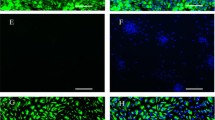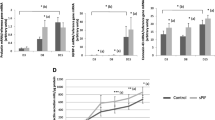Abstract
Trophoblast stem cells (TSCs) differentiate in an orderly manner, which plays an important role in the process of embryo implantation, placentation, and early pregnancy maintenance. At the maternal-fetal interface, the dialogue is crucial between trophoblast cells and endometrial epithelial cells. Previous studies suggested that galectin-I (Gal-I) may play an important role in placental development. In this study, we used Ishikawa (IK) cells-TSC coculture model to simulate the maternal-fetal interface and induce the differentiation of TSCs by differentiation media. The messenger RNA level of each cell type markers, fusion markers, and Gal-I was detected by quantitative reverse transcription polymerase chain reaction during the differentiation of TSCs. Wound healing and transwell invasion assays were used to detect the migration and invasion ability in each group. We found that coculture with IK cells or conditioned media from IK cells could promote the differentiation and invasion of TSCs and increase Gal-I expression in TSCs. Furthermore, recombinant Gal-I could also promote the differentiation and invasion of TSCs, suggesting that some of IK cells secretion increase the expression of Gal-I in TSCs during implantation, which then induced trophoblast differentiation and invasion in vitro. These findings provide significant insights into the biology of embryo-maternal interactions with the importance of Gal-I in TSCs for the successful establishment and maintenance of pregnancy.
Similar content being viewed by others
References
Paria BC, Reese J, Das SK, Dey SK. Deciphering the cross-talk of implantation: advances and challenges. Science. 2002;296(5576): 2185–2188.
Red-Horse K, Zhou Y, Genbacev O, et al. Trophoblast differentiation during embryo implantation and formation of the maternal-fetal interface. J Clin Invest. 2004;114(6):744–754.
Roberts RM, Fisher SJ. Trophoblast stem cells. Biol Reprod. 2011;84(3):412–421.
Rielland M, Hue I, Renard JP, Alice J. Trophoblast stem cell derivation, cross-species comparison and use of nuclear transfer: new tools to study trophoblast growth and differentiation. Dev Biol. 2008;322(1):1–10.
Barondes SH, Cooper DN, Girt MA, Leffler H. Galectins. Structure and function of a large family of animal lectins. J Biol Chem. 1994;269(33):20807–20810.
Cooper DN. Galectinomics: finding themes in complexity. Biochim Biophys Acta. 2002;1572(2–3):209–231.
Hughes RC. Galectins as modulators of cell adhesion. Biochimie. 2001;83(7):667–676.
Raz A, Lotan R. Endogenous galactoside-binding lectins: a new class of functional tumor cell surface molecules related to metastasis. Cancer Metastasis Rev. 1987;6(3):433–452.
Wells V, Mallucci L. Identification of an autocrine negative growth factor: mouse beta-galactoside-binding protein is a cytostatic factor and cell growth regulator. Cell. 1991;64(1):91–97.
Adams L, Scott GK, Weinberg CS. Biphasic modulation of cell growth by recombinant human galectin-1. Biochim Biophys Acta. 1996;1312(2):137–144.
Perillo NL, Pace KE, Seilhamer JJ, Baum LG. Apoptosis of T cells mediated by galectin-1. Nature. 1995;378(6558):736–739.
Vicovac L, Jankovic M, Cuperlovic M. Galectin-1 and -3 in cells of the first trimester placental bed. Hum Reprod. 1998;13(3): 730–735.
Maquoi E, van den Brule FA, Castronovo V, Foidart JM. Changes in the distribution pattern of galectin-1 and galectin-3 in human placenta correlates with the differentiation pathways of tropho-blasts. Placenta. 1997;18(5–6):433–439.
von Wolff M, Wang X, Gabius HJ, Strowitzki T. Galectin finger-printing in human endometrium and decidua during the menstrual cycle and in early gestation. Mol Hum Reprod. 2005;11(3): 189–194.
Bozic M, Petronijevic M, Milenkovic S, Atanackovic J, Lazic J, Vicovac L. Galectin-1 and galectin-3 in the trophoblast of the gestational trophoblastic disease. Placenta. 2004;25(10):797–802.
Kolundzic N, Bojic-Trbojevic Z, Kovacevic T, Stefanoska I, Kadoya T, Vicovac L. Galectin-1 is part of human trophoblast invasion machinery-a functional study in vitro. PLoS One. 2011;6(12):e28514.
Walzel H, Blach M, Hirabayashi J, Kasai KI, Brock J. Involve-ment of CD2 and CD3 in galectin-1 induced signaling in human Jurkat T-cells. Glycobiology. 2000;10(2):131–140.
Blois SM, Ilarregui JM, Tometten M, et al. A pivotal role for galectin-1 in fetomaternal tolerance. Nat Med. 2007;13(12): 1450–7.
Jeschke U, KarstenU, Wiest I, et al. Binding of galectin-1 (gal-1) to the Thomsen-Friedenreich (TF) antigen on trophoblast cells and inhibition of proliferation of trophoblast tumor cells in vitro by gal-1 or an anti-TF antibody. Histochem Cell Biol. 2006; 126(4):437–444.
Liu AX, Jin F, Zhang WW, et al. Proteomic analysis on the alteration of protein expression in the placental villous tissue of early pregnancy loss. Biol Reprod. 2006;75(3):414–420.
Tirado-Gonzalez I, Freitag N, Barrientos G, et al. Galectin-1 influences trophoblast immune evasion and emerges as a predictive factor for the outcome of pregnancy. Mol Hum Reprod. 2011; 19(1):43–53.
Hannan NJ, Paiva P, Dimitriadis E, Salamonsen LA. Models for study of human embryo implantation: choice of cell lines?. Biol Reprod. 2010;82(2):235–245.
Nishida M, Kasahara K, Kaneko M, Iwasaki H, Hayashi K. Estab-lishment of a new human endometrial adenocarcinoma cell line, Ishikawa cells, containing estrogen and progesterone receptors [in Japanese]. Nihon Sanka Fujinka Gakkai Zasshi. 1985;37(7): 1103–1111.
Heneweer C, Schmidt M, Denker HW, Thie M. Molecular mechanisms in uterine epithelium during trophoblast binding: the role of small GTPase RhoA in human uterine Ishikawa cells. J Exp Clin Assist Reprod. 2005;2(1):4.
Castelbaum AJ, Ying L, Somkuti SG, Sun J, Ilesanmi AO, Lessey BA. Characterization of integrin expression in a well differentiated endometrial adenocarcinoma cell line (Ishikawa). J Clin Endocrinol Metab. 1997;82(1):136–142.
Simmons DG, Fortier AL, Cross JC. Diverse subtypes and developmental origins of trophoblast giant cells in the mouse placenta. Dev Biol. 2007;304(2):567–578.
Coan PM, Conroy N, Burton GJ, Ferguson-Smith AC. Origin and characteristics of glycogen cells in the developing murine placenta. Dev Dyn. 2006;235(12):3280–3294.
Anson-Cartwright L, Dawson K, Holmyard D, Fisher SJ, Lazzarini RA, Cross JC. The glial cells missing-1 protein is essential for branching morphogenesis in the chorioallantoic placenta. Nat Genet. 2000;25(3):311–314.
Simmons DG, Natale DR, Begay V, Hughes M, Leutz A, Cross JC. Early patterning of the chorion leads to the trilaminar tropho-blast cell structure in the placental labyrinth. Development. 2008; 135(12):2083–2091.
Norwitz ER, Schust DJ, Fisher SJ. Implantation and the survival of early pregnancy. N EnglJ Med. 2001; 345(19): 1400–1408.
Cakmak H, Taylor HS. Implantation failure: molecular mechanisms and clinical treatment. Hum Reprod Update. 2011; 17(2):242–253.
Gellersen B, Reimann K, Samalecos A, et al. Invasiveness of human endometrial stromal cells is promoted by decidualization and by trophoblast-derived signals. Hum Reprod. 2010;25(4): 862–73.
Kimber SJ, Spanswick C. Blastocyst implantation: the adhesion cascade. Semin Cell Dev Biol. 2000;11(2):77–92.
Bischof P, Campana A. A model for implantation of the human blastocyst and early placentation. Hum Reprod Update. 1996; 2(3):262–270.
Wang H, Dey SK. Roadmap to embryo implantation: clues from mouse models. Nat Rev Genet. 2006;7(3):185–199.
Aplin JD, Kimber SJ. Trophoblast-uterine interactions at implantation. Reprod Biol Endocrinol. 2004;2:48.
Ai Z, Jing W, Fang L. Cytokine-like protein 1 (Cytll): a potential molecular mediator in embryo implantation. PLoS One. 2016; 11(1):e147424.
Atwood CS, Vadakkadath MS. The spatiotemporal hormonal orchestration of human folliculogenesis, early embryogenesis and blastocyst implantation. Mol Cell Endocrinol. 2016;430:33-48.
Tanaka S, Kunath T, Hadjantonakis AK, Nagy A, Rossant J. Promotion of trophoblast stem cell proliferation by FGF4. Sci-ence. 1998;282(5396):2072–2075.
Rossant J, Cross JC. Placental development: lessons from mouse mutants. Nat Rev Genet. 2001;2(7):538–548.
Georgiadis V, Stewart HJ, Pollard HJ, et al. Lack of galectin-1 results in defects in myoblast fusion and muscle regeneration. Dev Dyn. 2007;236(4): 1014–1024.
Yang M, Lei ZM, Rao Ch V. The central role of human chorionic gonadotropin in the formation of human placental syncytium. Endocrinology. 2003;144(3):1108–11020.
Douglas GC, King BF. Differentiation of human trophoblast cells in vitro as revealed by immunocytochemical staining of desmoplakin and nuclei. J Cell Sci 1990;96(pt 1):131–141.
Stepan H, Faber R, Dornhofer N, Huppertz B, Robitzki A, Walther T. New insights into the biology of preeclampsia. Biol Reprod. 2006;74(5):772–776.
George EM, Granger JP. Recent insights into the pathophysiology of preeclampsia. Expert Rev Obstet Gynecol. 2010;5(5): 557–566.
Zhang D, Lv P, Zhang R, et al. A new model for embryo implan-tation: coculture of blastocysts and Ishikawa cells. Gynecol Endocrinol. 2012;28(4):288–292.
Kaneko Y, Day ML, Murphy CR. Integrin beta3 in rat blastocysts and epithelial cells is essential for implantation in vitro: studies with Ishikawa cells and small interfering RNA transfection. Hum Reprod. 2011;26(7):1665–1674.
Dwek RA. Glycobiology: more functions for oligosaccharides. Science. 1995;269(5228):1234–1235.
Yamaoka K, Ohno S, Kawasaki H, Suzuki K. Overexpression of a beta-galactoside binding protein causes transformation of BALB3T3 fibroblast cells. Biochem Biophys Res Commun. 1991;179(1):272–279.
Fischer I, Redel S, Hofmann S, et al. Stimulation of syncytium formation in vitro in human trophoblast cells by galectin-1. Placenta. 2010;31(9):825–832.
James JL, Stone PR, Chamley LW. Cytotrophoblast differentiation in the first trimester of pregnancy: evidence for separate progenitors of extravillous trophoblasts and syncytiotrophoblast. Reproduction. 2005;130(1):95–103.
Bevan BH, Kilpatrick DC, Liston WA, Hirabayashi J, Kasai K. Immunohistochemical localization of a beta-D-galactoside-binding lectin at the human maternofetal interface. Histochem J. 1994;26(7):582–586.
Lessey BA. The role of the endometrium during embryo implantation. Hum Reprod. 2000;15(suppl 6):39–50.
Lessey BA, Castelbaum AJ. Integrins and implantation in the human. Rev Endocr Metab Disord. 2002;3(2): 107–117.
Reis FM, D’Antona D, Petraglia F. Predictive value of hormone measurements in maternal and fetal complications of pregnancy. Endocr Rev. 2002;23(2):230–257.
Author information
Authors and Affiliations
Corresponding authors
Rights and permissions
About this article
Cite this article
Tang, M., You, J., Wang, W. et al. Impact of Galectin-I on Trophoblast Stem Cell Differentiation and Invasion in In Vitro Implantation Model. Reprod. Sci. 25, 700–711 (2018). https://doi.org/10.1177/1933719117725816
Published:
Issue Date:
DOI: https://doi.org/10.1177/1933719117725816




